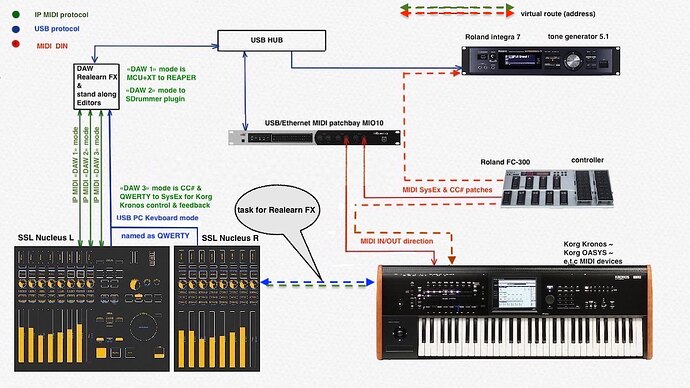The results of the investigation into the recognition and execution of KM MIDI messages in a studio environment with peripheral equipment, DAW and stand alone VSTi:
-
When KM-sending a "pure" MIDI message
90 64 7F(Note-on only):
1.1 in a DAW: LPX is recognizes and executes the message on any AUi installed on the track in all cases (due to the MIDI KM-source is connected by default, or unless if the KM source is forcibly not disabled (using Logic inviroment));
1.2 in Stand alone VSTi - recognition and execution occurs only in the case of a specific assignment of the KM source to the input port of the VSTi;
1.3 MIDI receiving peripherals (with USB-MIDI, ipMIDI, or by other ethernet connection protocols) do not recognize and therefore do not execute this message (whether in the host-off or host-on DAW state). this statement is limited to the list of my equipment, therefore it is not absolute! (SSL nucleus 2 controller via ipMIDI, Roland integra-7 and Korg Kronos synths via USB-MIDI, Korg OASYS synth via ethernet connection using Mio10 MIDI patchbay). -
When KM-sending the raw SysEx (
F0 00 00 66 10 12 90 64 7F F7- which a priori controversial / incorrect method for sending an encapsulated message part as "Note-on":90 64 7F):
2.1 SysEx not recognized by DAW! Even if partially interpreted as Note-on part from SysEx);
2.2 Stand alone VSTi - continues to recognize encapsulated Note-on part when forcing KM-suorce to MIDI input port of VSTi;
2.3 - peripheral equipments - will not recognize this message in any case.
Сonclusion:
-
MIDI "Note-on" message from KM source is only executed within MacOS (DAW or SA VSTi) unless MIDI input is forced disabled in MIDI-inviroment settings, or AUi/VSTi channels are inconsistent
-
A MIDI "Note-on" message encapsulated in SysEx and sent from the KM - only Stand Alone VSTi that are preset to the KM source are recognized. in other cases - the message is ignored! which is to be expected, according to the theoretical description of the MIDI implementation chart.
-
At this time the Keyboard Maestro cannot and doesn't have the ability to send the required MIDI messages to certain/expected peripheral equipment without "crutches" software-intermediaries! Including as feedback to MCU-emulation controllers.
